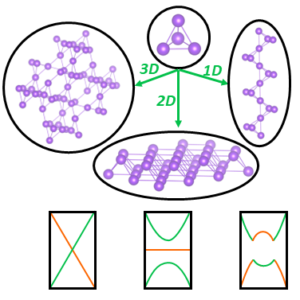Quantum materials are on the verge of revolutionizing a variety of fields such as spintronics, memory storage, and energy-efficient devices. Creating and controlling quantum materials holds immense potential for impactful applications. However, clear design principles for novel quantum materials are still not available. Moreover, some quantum states of matter, such as superconductivity, only emerge under extreme conditions, namely high pressure or low temperature. To explore quantum phenomena in solids, we use chemical knowledge and methods to bridge the gap between chemistry and physics and form a chemical perspective on and a general understanding of complex quantum phenomena.
Design rules for quantum materials

Many known quantum materials possess distinct lattices, such as honeycomb, kagome, or pyrochlore, highlighting the importance of bonding patterns in the creation of quantum properties. However, quantum materials’ properties also depend on the chemical nature of elements composing and surrounding the lattice. We use chemical modeling and data science to explore new bonding patterns, new material compositions, and the dynamic relationships between these bonding patterns and material compositions. In addition to the identification of new quantum material candidates, we work on improving the design rules for materials to harness their properties for exciting new applications.
Accessing quantum phases

Depending on the external conditions, a material exists in different phases. Sometimes, these phases have vastly different properties, such as metallic 1T and semiconducting 2H phases of MoTe2. Usually, phase transitions are induced by changes in temperature, pressure, or chemical doping. We explore using light and lattice vibrations to drive phase transitions, especially between classical (e.g. semiconducting) and quantum (e.g. superconducting) phases of matter. Developing these methods will facilitate device implementations of quantum materials by allowing us to control access to quantum behavior.